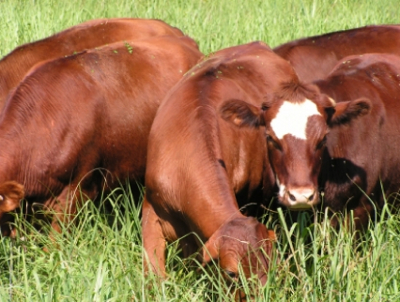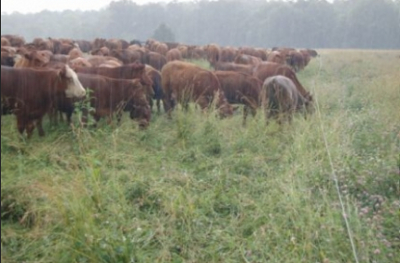
Recovery period and trampling define mob grazing
 So how does mob grazing
differ from management
intensive grazing?
The biggest differences are how long you let the plants grow back after
being grazed (the recovery
period) and the
intentional trampling of some grass.
So how does mob grazing
differ from management
intensive grazing?
The biggest differences are how long you let the plants grow back after
being grazed (the recovery
period) and the
intentional trampling of some grass.
When he was following
the management intensive system, Greg Judy used to rotate his animals
so quickly that they nibbled on the same plots of land eight times per
year, but now he's cut back to five annual rotations. Rather than
striving to keep the grass short, he lets the plants grow up to what he
calls the boot stage, in which each plant has three to four leaves and
is developing a seed head (although the head is not yet visible.)
He notes that waiting to graze until the boot stage helps the pasture
grow 40% more biomass compared to faster rotations.
In order to achieve
these long recovery periods without cutting back the number of animals
on his farm, Greg combines his herds together and manages all twelve of
his farms as one unit. Even though that means he sometimes has to
drive cattle a couple of miles down the road to a new farm, the system
pays off by giving his pastures more time to recover between grazing
episodes.
 The second factor that
differentiates mob grazing from management intensive grazing is
trampling. Every time Greg turns his cows into a new plot of
land, he aims for them to eat only 60% of the grass. Another 30%
is trampled into the ground, with the final 10% left standing to
provide a wind break and preserve moisture and wildlife habitat.
The second factor that
differentiates mob grazing from management intensive grazing is
trampling. Every time Greg turns his cows into a new plot of
land, he aims for them to eat only 60% of the grass. Another 30%
is trampled into the ground, with the final 10% left standing to
provide a wind break and preserve moisture and wildlife habitat.
Again, Greg's method of
ensuring that a lot of the grass gets trampled involves bunching
animals up --- a high stocking density (lots of cows in the same small
paddock) inevitably mash down a lot of grass. Waiting to turn the
cows onto pasture until plants are mature also helps since the older
grass will break rather than springing back once trampled.
Trampled grass in a
pasture may seem wasteful, but is actually similar to adding compost
and mulch to your garden. Dead grass left behind on the soil
surface feeds microorganisms (which in turn feed the pasture plants),
and the organic matter added to the soil holds moisture and maintains a
healthy soil food web. "For every grass blade you trample," Greg
Judy says, "You'll get two back."
 This post is part of our Mob Grazing lunchtime series.
Read all of the entries: This post is part of our Mob Grazing lunchtime series.
Read all of the entries:
|
Want more in-depth information? Browse through our books.
Or explore more posts by date or by subject.
About us: Anna Hess and Mark Hamilton spent over a decade living self-sufficiently in the mountains of Virginia before moving north to start over from scratch in the foothills of Ohio. They've experimented with permaculture, no-till gardening, trailersteading, home-based microbusinesses and much more, writing about their adventures in both blogs and books.
Want to be notified when new comments are posted on this page? Click on the RSS button after you add a comment to subscribe to the comment feed, or simply check the box beside "email replies to me" while writing your comment.
